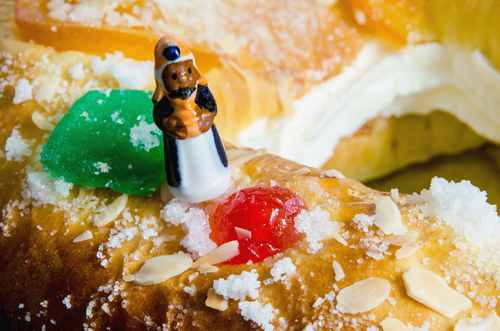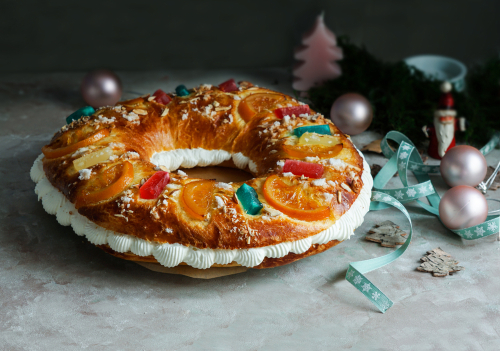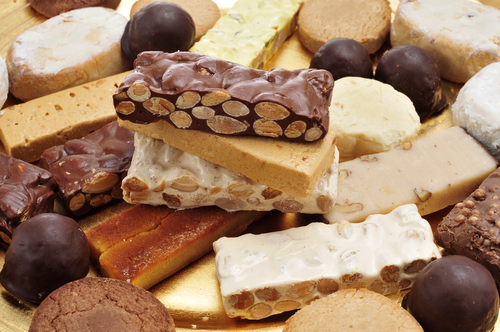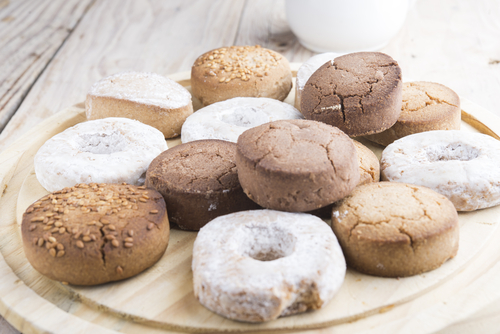As Christmas approaches, and especially this unusual year, you might want to feel a bit closer to the Spanish culture, by enjoying some typical Spanish Christmas sweets and desserts, that you can bake at home or buy online or at a specialised store.
1.Roscón de Reyes
This is not only a very tasty dessert, but it’s also lots of fun to prepare and eat. This ring-shaped cake, also known as King Cake or Three Kings’ Cake, has two secrets in it: a figurine and a bean. Whoever finds the figurine gets crowned as the King, and whoever finds the bean, pays for it. It owes its name to the Three Kings’ Day (January 6th), the day when it’s usually eaten.

This is an easy and fun pastry to bake at home as a family activit, and we have prepared this recipe for you!
Ingredients
- 4 cups of unbleached flour
- 1/2 teaspoon of salt
- 1-ounce of active dry yeast
- 1/3 cup of lukewarm milk (mixed with 1/3 cup of lukewarm water)
- 6 tablespoons of butter
- 6 tablespoons of sugar
- Grated rind of 1 lemon
- Grated rind of 1 orange
- 2 large eggs
- 1 tablespoon of brandy
- 1 tablespoon of water
- 1 large white egg (lightly beaten)
- 2 cups of candied fruit (assorted figs, oranges, lemons, mangos or cherries, chopped or left in large pieces)
Steps:
- Sift flour and salt together in a large mixing bowl. Make a hole in the centre of the flour.
- In a small mixing bowl, stir and dissolve the dry yeast in the lukewarm milk mixed with the lukewarm water.
- Once dissolved, pour the dissolved yeast into the centre of the flour. Stir in just enough flour from around the sides of the bowl to make a thick batter.
- With your hand, grab about a teaspoon of the flour from the side of the bowl and sprinkle it over the top of the batter.
- Cover the bowl with a kitchen towel and leave in a warm place, away from any draft. Allow batter to turn spongy, about 15 minutes.
- In a medium-size mixing bowl, use a hand mixeror whisk to beat together the butter and sugar. The mixture should be smooth and creamy. Set aside.
- Add and mix in grated orange and lemon rinds, eggs, brandy and water to the bowl with the flour mixture. The dough should be sticky.
- Beat flour mixture until it is elastic and smooth. Beat in the reserved butter-sugar mixture and mix until the dough is smooth. The dough should be formed into a ball, then covered with oiled plastic wrap.
- Cover the bowl with a kitchen towel and leave it again in a warm place and allow to rise until doubled in size. This will take approximately 1 1/2 hours.
- While you are waiting for the dough to rise, grease a large baking sheet with vegetable shortening and set aside for later use. If you will use a baking stone, no need to grease it.
- Once the dough has doubled, remove the plastic wrap and punch down dough. Lightly flour a clean counter or cutting board and place dough on it.
- Knead for 2 to 3 minutes. Then, using a rolling pin, roll dough into a long rectangle, about 2 feet long and 5 to 6 inches wide.
- Roll the dough from the long side into a sausage shape.
- Carefully place the dough onto the large baking sheet or stone and connect the ends together, forming a ring. If you will hide a bean or a small foil-wrapped ceramic figurine in the cake, now is the time to tuck it under the dough. Cover with oiled plastic wrap again. Leave in a warm place and allow to double in size. This will take about 1 to 1 1/2 hours.
- Heat oven to 350 F. Lightly beat the egg whitein a small bowl. Uncover the dough and brush the top of the cake with the beaten egg white. Decorate the ring with the candied fruit pieces. Push them into the dough slightly so that they do not fall off.
- Place in oven and bake for about 30 minutes or until golden. Allow to cool on a rack before serving.
In the last half of the 20th century, filling the Roscón with whipped cream or a thick custard became popular. Today about a third of these pastries made and sold in Spain are filled. If you want to fill yours, use a bread knife to slice the bread in half horizontally and carefully remove the top. Next, squeeze in the whipped cream or filling you’ve chosen and carefully replace the top. Keep refrigerated until serving if filled with cream or custard.

2. Turrón
Another Spanish Christmas sweet you can easily find at this time of the year anywhere in Spain or in specialised stores abroad, or otherwise online is the delicious nougat bar called Turrón.
The most typical turron comes from Alicante, Jijona (Xixona). Its main ingredients are peeled roasted almonds and honey. The Turrón can be hard or soft, and many varieties exist such as dark, milk or white chocolate nougat, coconut, or other variations with whiskey or liquor.
Its origins are uncertain, although history has proved that the Arabs were used to putting almonds and honey in their sweets. Barcelona and Alicante have claimed the creation of the Turrón to be their own; wherever the truth may lie, what’s sure is that countless Spanish factories look forward to Christmas (and the previous months, too) to sell this well-known sweet throughout Europe.

3. Mantecados and polvorones
The Mantecado is one of the most typical Christmas sweets from the region of Andalucía, which first appeared in the bakeries of Antequera, as some say, or Estepa (Seville province), as others state. Its curious origins are related to the excess of cereals and piglet lard during the 16th century.
The Mantecado (from “manteca”, which in Spanish means “lard”) are made of wheat flour, lard, sugar and egg white. They are later flavoured with either cinnamon, almond, chocolate or lemon, among others. This square-shaped sweet is also widespread throughout the year, although it’s during Christmas when the selling peaks.
A variety of the Mantecado is the round-shaped Polvorón, which, however, has much more flour, it lacks egg white, and it always has almonds inside, in contrast with the Mantecado. Unsurprisingly, its name comes from the excess of flour, which make it seem like it’s covered in dust (i.e. “polvo” is the Spanish word for powder). The Polvorones are eaten only during Christmas time, they are wrapped up in colourful paper, and they usually crumble apart when opened.


